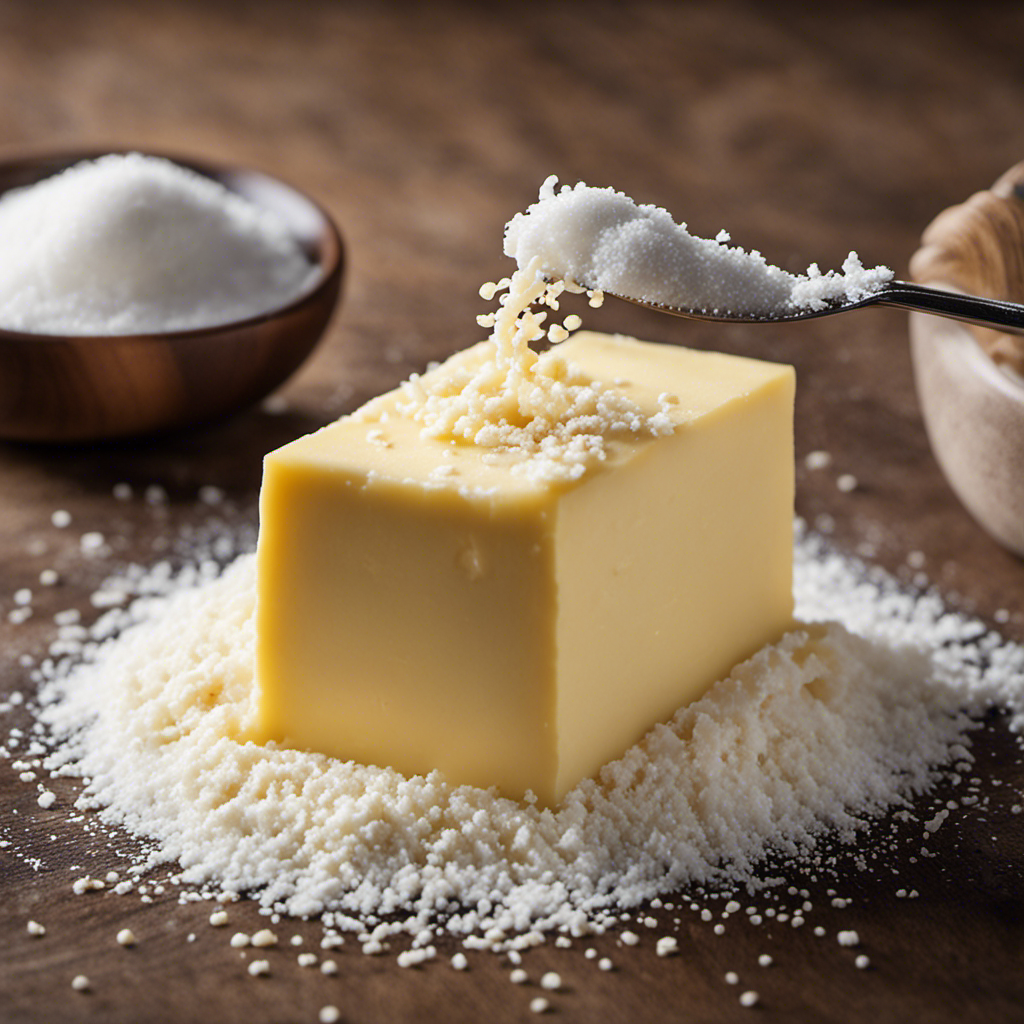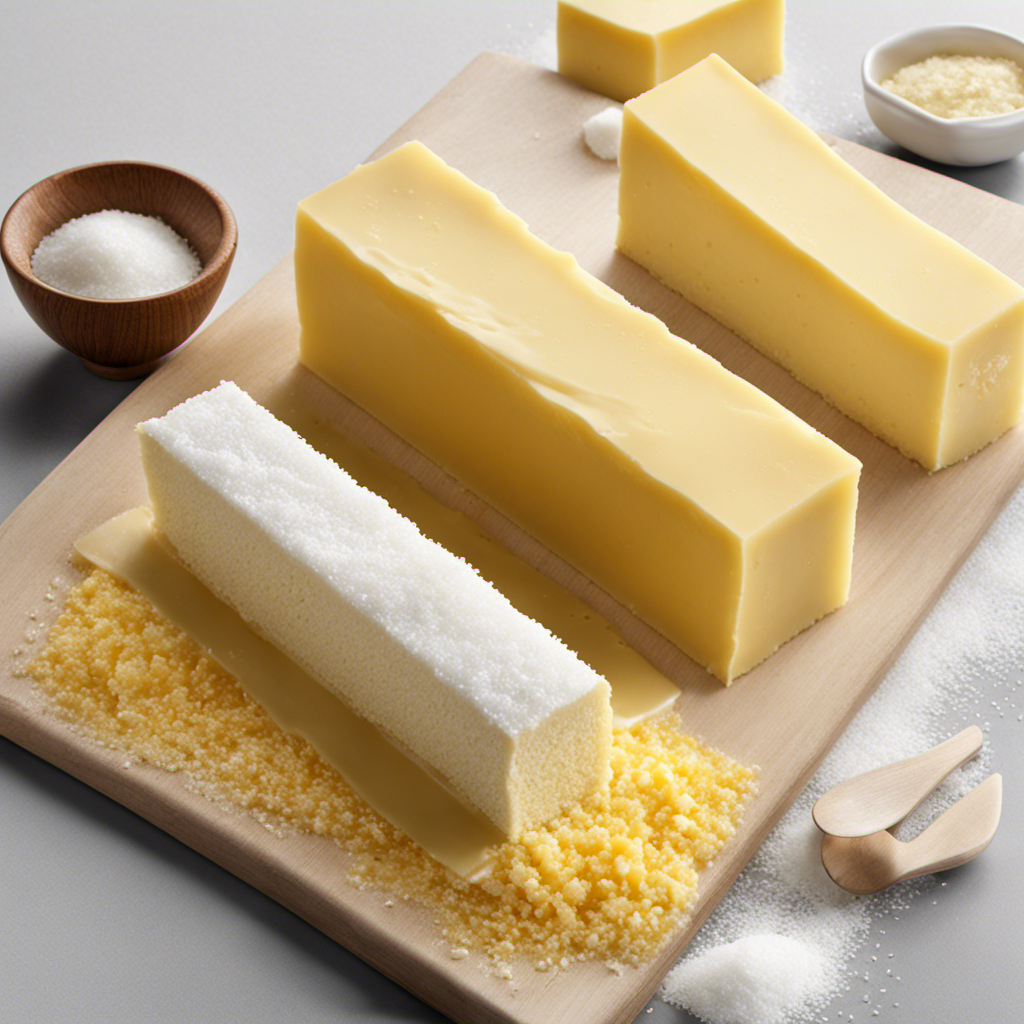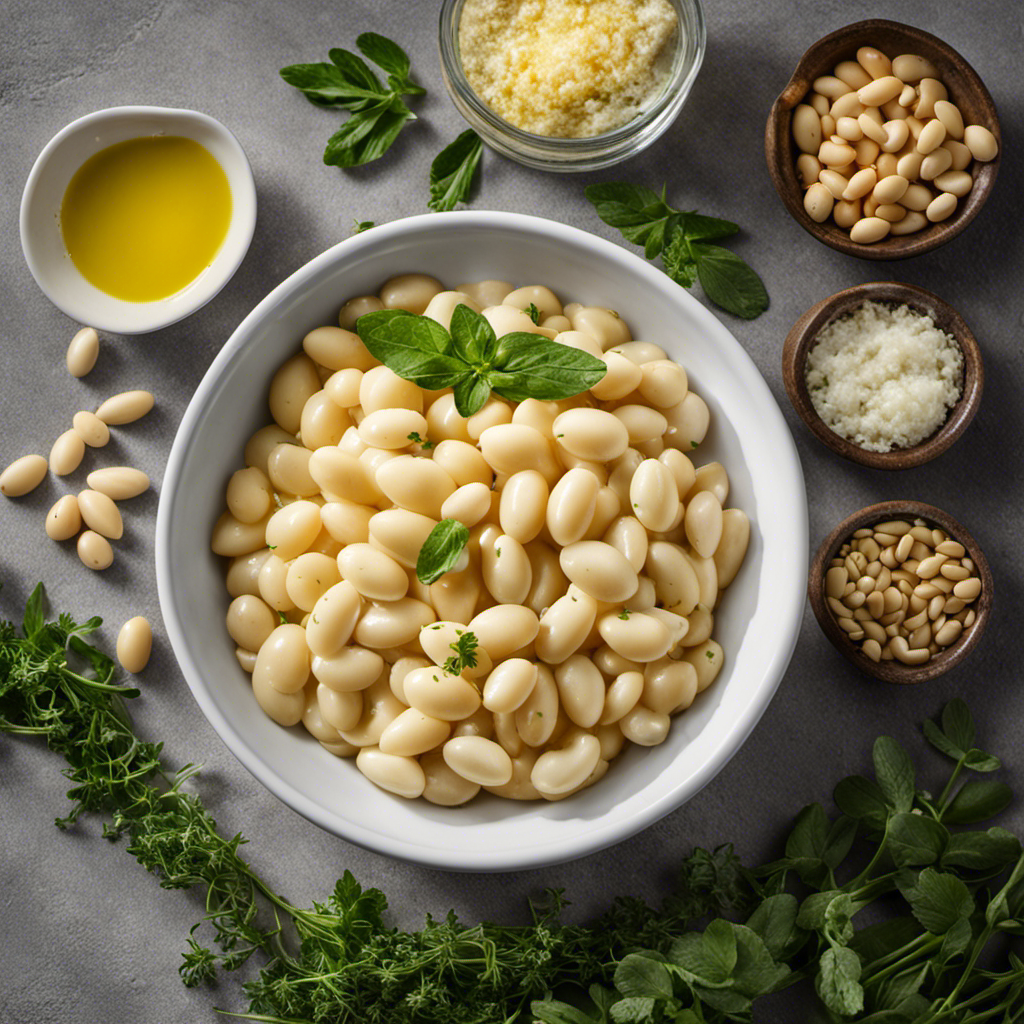As someone who loves pasta, I have always thought that buttered noodles can be elevated beyond a basic dish. With a little creativity, they can become a culinary delight that will leave your taste buds thrilled.
In this article, I will share with you my tried and true methods for taking butter noodles to the next level. Get ready to elevate your pasta game and indulge in a bowl of heavenly, flavor-packed goodness.
Key Takeaways
- Consider using smooth and long pasta, like spaghetti or fettuccine, for butter noodles to allow the butter to coat the noodles evenly and capture the butter sauce.
- Experiment with alternative butter options like flavored butters or ghee to add complexity to your butter noodles.
- Elevate the butter flavor by adding herbs to the butter or toasting the butter for a rich, nutty flavor.
- Use flavored butter, such as garlic or lemon butter, to enhance the taste of your butter noodles and create a gourmet experience.
Choosing the Right Noodle
When choosing the right noodle for butter noodles, it’s important to consider the texture and shape.
Personally, I believe that a smooth and long pasta, like spaghetti or fettuccine, works best for butter noodles. The smooth texture allows the butter to coat the noodles evenly, creating a luxurious and velvety mouthfeel.
The long shape also helps to capture and hold the butter sauce, ensuring that every bite is bursting with flavor.
Of course, there are alternative butter options to consider as well. While traditional butter is always a classic choice, you can also experiment with flavored butters or even try using ghee for a nuttier taste.
With the right pasta and butter combination, you can truly elevate the buttery flavor in your noodles.
Elevating the Butter Flavor
When it comes to elevating the flavor of butter, there are a few key techniques I swear by.
First, adding herbs to the butter can infuse it with a burst of fresh, aromatic flavors that will take your dish to the next level. I love using herbs like rosemary, thyme, or basil, depending on the dish.
Second, toasting the butter before using it adds a rich, nutty flavor that enhances the overall taste of the dish.
Lastly, using flavored butter, like garlic or lemon butter, can instantly add a punch of flavor and complexity to any recipe. Trust me, these simple tricks will make your buttery dishes stand out and leave everyone craving for more.
Adding Herbs for Flavor
Adding herbs to your butter noodles can enhance their flavor and make them more delicious. When it comes to herb pairing, there are a few combinations that work exceptionally well.
One of my personal favorites is basil and parsley. These two herbs complement each other perfectly, adding a fresh and aromatic touch to the buttery noodles. To infuse the butter with herbs, simply melt it in a pan and add finely chopped basil and parsley. Allow the herbs to simmer in the butter for a few minutes, allowing their flavors to mingle and infuse the butter.
The result is a rich, herb-infused butter that coats the noodles beautifully. The combination of the buttery richness and the fragrant herbs creates a burst of flavor with every bite, taking your simple butter noodles to the next level.
Toasting the Butter
To enhance the flavor of your noodles, try toasting the butter before adding the herbs. Toasting butter is a simple technique that can elevate the taste of your dish to a whole new level. Here are the benefits and techniques of toasting butter:
-
Adds a rich, nutty flavor: Toasting butter gives it a deeper, more complex taste that adds a delightful nuttiness to your butter noodles.
-
Enhances aroma: The process of toasting butter releases aromatic compounds, filling your kitchen with a mouthwatering scent.
-
Improves texture: Toasting butter creates a slightly crispy texture, adding a pleasant crunch to your noodles.
To toast butter, simply melt it in a pan over medium heat and cook until it turns golden brown, being careful not to burn it. The nutty aroma and flavor will instantly take your butter noodles to the next level.
Now, let’s explore how to use flavored butter to enhance your dish even further.
Using Flavored Butter
Using flavored butter is a creative way to infuse your dish with unique and delicious flavors. It adds that extra burst of taste that elevates a simple butter noodles dish into a gourmet experience. There are various flavored butter alternatives that you can use to enhance your butter noodles recipes. From herb-infused butters like garlic and rosemary to savory options like truffle and bacon, the possibilities are endless. These flavored butters not only bring a depth of flavor, but also add a beautiful aroma to your dish. To give you an idea of the flavor combinations you can create, here is a table showcasing three mouthwatering butter noodle recipes:
| Flavored Butter Alternative | Butter Noodle Recipe |
|---|---|
| Garlic and Herb Butter | Lemon Garlic Butter Noodles |
| Truffle Butter | Truffle Parmesan Butter Noodles |
| Bacon Butter | Creamy Bacon Alfredo Noodles |
With these creative butter noodle recipes, you can easily impress your family and friends with a simple yet flavorful dish. So go ahead and experiment with different flavored butters to take your butter noodles to the next level of deliciousness.
Adding a Touch of Herbs
Sprinkle some dried herbs to give your butter noodles a burst of flavor. Herbs are a great way to elevate the taste of a simple dish like butter noodles. Whether you prefer fresh or dried herbs, they can add a punch of freshness and aroma to your pasta.
Here are three herb pairings that work wonders with specific types of noodles:
-
Basil: This classic herb pairs wonderfully with spaghetti or linguine. Its sweet and slightly peppery flavor adds a touch of sophistication to your butter noodles.
-
Rosemary: This robust herb is perfect for pairing with thicker noodles like fettuccine or pappardelle. Its pine-like aroma and earthy flavor create a hearty and comforting dish.
-
Parsley: For a light and refreshing twist, sprinkle some parsley on angel hair or capellini noodles. Its mild and slightly tangy taste adds a pop of color and freshness to your buttery creation.
Incorporating Savory Ingredients
When it comes to elevating a dish, adding the right spices can make all the difference. A dash of cayenne pepper or a sprinkle of paprika can bring a burst of flavor that takes a meal from ordinary to extraordinary.
And let’s not forget about cheese – its creamy texture and rich taste can turn a simple dish into a decadent delight.
Finally, herbs are like a breath of fresh air in a recipe, adding a vibrant and fragrant touch that invigorates the senses.
Spices for Added Flavor
To enhance the taste of your butter noodles, try adding a pinch of garlic powder or a dash of black pepper. These simple spices can take your plain noodles to a whole new level of flavor.
But why stop there? Spices are a creative way to elevate any dish, including butter noodles. Here are three seasoning blends that you can try to add a burst of flavor to your noodles:
-
Italian seasoning: This blend of herbs like oregano, basil, and thyme adds a savory and aromatic touch to your butter noodles.
-
Cajun seasoning: If you like a bit of heat, sprinkle some Cajun seasoning on your noodles. The blend of spices like paprika, cayenne pepper, and garlic powder will give your dish a spicy kick.
-
Lemon pepper seasoning: For a zesty and tangy twist, try adding some lemon pepper seasoning to your butter noodles. The combination of citrusy lemon and spicy black pepper will tantalize your taste buds.
Experimenting with different seasoning blends can transform your butter noodles into a flavorful masterpiece. So don’t be afraid to get creative in the kitchen!
Cheese for Creaminess
If you’re looking to add a creamy element to your buttery noodles, try melting some shredded cheese into the mix. It’s a simple yet effective way to elevate the flavors and texture of your dish.
I love experimenting with different cheeses to find the perfect one for my butter noodles. Gouda adds a smoky richness, while Parmesan brings a salty, nutty taste.
To enhance the flavors even more, I like to sauté some garlic and onion in the butter before adding the cheese. This adds a delicious depth of flavor that complements the creaminess of the cheese.
Now, let’s move on to the next step and talk about how to use herbs for freshness in your buttery noodles.
Herbs for Freshness
You can add a pop of freshness to your dish by sprinkling some chopped herbs, such as parsley or basil, on top of your buttery noodles.
Herbs are a fantastic way to elevate the flavors in your pasta dishes and add a burst of freshness. When it comes to butter-based sauces, incorporating herbs can take your dish to a whole new level.
Here are three ways to use herbs for freshness in other pasta dishes and incorporate them into butter-based sauces:
- Mix chopped herbs into melted butter and drizzle it over your noodles for a simple yet flavorful sauce.
- Toss cooked pasta with a mixture of melted butter, garlic, and freshly chopped herbs for a fragrant and delicious dish.
- Make a compound butter by blending softened butter with finely chopped herbs, then use it to coat your cooked noodles for a burst of herbaceous flavor.
Using herbs in your buttery pasta dishes will add a vibrant and refreshing touch that will impress your taste buds.
Experimenting With Different Cheeses
Try using different cheeses to add variety and flavor to your butter noodles. Experimenting with different toppings and pairing them with different proteins can elevate your simple dish to a whole new level.
When it comes to cheeses, the possibilities are endless. Personally, I love using Parmesan for a rich and nutty flavor, or a sharp cheddar for a creamy and tangy bite. Mozzarella adds a gooey and melty texture, while Gruyere brings a savory and slightly sweet taste. Don’t be afraid to mix and match cheeses to create your own unique combination.
For a twist, try using blue cheese for a bold and pungent kick, or feta for a salty and crumbly contrast. The key is to experiment and find the cheese that perfectly complements your butter noodles and enhances your overall dining experience.
Enhancing With Garlic and Onion
After experimenting with different cheeses to make my butter noodles better, I decided to explore alternative seasoning options to enhance the flavor even more. While garlic and onion are commonly used to add depth and complexity to dishes, some people may not be able to tolerate them due to allergies or digestive issues. Thankfully, there are plenty of alternatives available that can provide a similar taste profile without the drawbacks.
Here are three alternative seasoning options that can elevate your butter noodles to new heights:
-
Shallots: These mild-flavored bulbs are a close cousin to onions and garlic, offering a subtle yet distinct taste.
-
Scallions: Also known as green onions, they add a fresh, slightly pungent flavor that complements buttery noodles beautifully.
-
Leeks: With their delicate and sweet flavor, leeks provide a milder alternative to onions, making them a perfect choice for those looking to avoid strong flavors.
Garnishing for a Beautiful Presentation
To enhance the presentation of your butter noodles, consider garnishing them with a sprinkle of fresh herbs or a drizzle of flavored oil. These simple garnishing techniques can elevate a basic dish to a whole new level of sophistication.
Picture a steaming plate of perfectly cooked noodles, coated in a rich and velvety butter sauce. Now imagine the vibrant green of freshly chopped parsley delicately scattered on top, adding a pop of color and a burst of freshness.
Or perhaps you prefer the earthy aroma of rosemary-infused olive oil, gently drizzled over the noodles, imparting a subtle hint of flavor.
These plating techniques not only make your dish visually appealing, but they also enhance the overall dining experience by adding layers of complexity and freshness.
Frequently Asked Questions
Can I Use Any Type of Noodle for Butter Noodles?
Yes, you can use any type of noodle for butter noodles. However, using rice instead of noodles for butter noodles may not give you the same texture and taste. To add a spicy kick, try adding red pepper flakes or hot sauce.
How Can I Make the Butter Flavor More Intense?
To make the butter flavor in noodles more intense, I suggest infusing them with garlic and herbs. This adds depth and richness. Additionally, adding a touch of spice, like red pepper flakes, can elevate the flavor profile even further.
What Are Some Herbs That Pair Well With Butter Noodles?
Some common seasonings for butter noodles include garlic powder, dried parsley, and black pepper. If you want to add a touch of sweetness, a sprinkle of brown sugar or a drizzle of honey works well.
Are There Any Unique Savory Ingredients That I Can Add to Butter Noodles?
Adding unique savory ingredients to butter noodles can elevate their flavor profile. With creative twists like garlic-infused oil, crispy bacon crumbles, or a sprinkle of Parmesan cheese, you can transform simple butter noodles into a delicious and satisfying dish.
Can I Use Any Type of Cheese to Enhance My Butter Noodles?
Yes, you can definitely use different types of cheese to enhance your butter noodles. Adding a creamy cheese like Parmesan or a sharp cheddar can take your dish to the next level.
Conclusion
In conclusion, making butter noodles better is all about taking simple ingredients and transforming them into a delicious and satisfying dish. By choosing the right noodle and elevating the butter flavor, you can create a base that is rich and flavorful.
Adding herbs, savory ingredients, and experimenting with different cheeses can take your butter noodles to the next level. And let’s not forget about the power of garlic and onion to enhance the overall taste.
Finally, garnishing your creation for a beautiful presentation will make it even more enticing.
Did you know that noodles have been a staple in Chinese cuisine for over 4,000 years? This long-standing tradition shows the enduring appeal and versatility of this simple yet satisfying dish.










